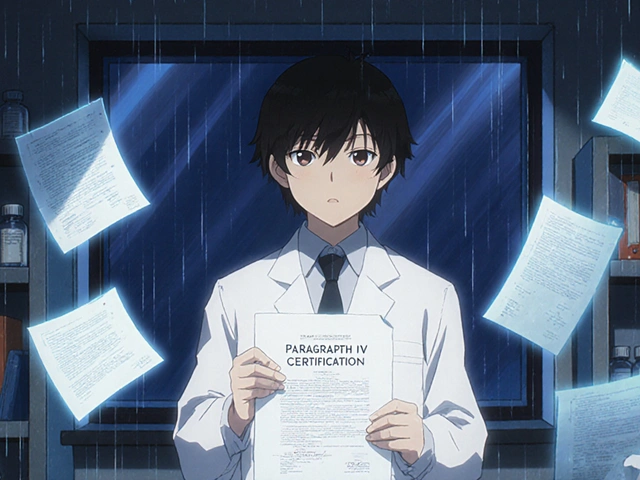Candidemia Genetic Risk Calculator
Select the genetic variants present in the patient:
Genetic susceptibility to candidemia is a host genetic trait that influences the risk of bloodstream Candida infections and their spread throughout the body.
- Understand which genes tip the balance toward candidemia.
- See how specific polymorphisms affect immune signalling.
- Learn practical ways clinicians use genetics for risk stratification.
- Get a quick comparison of the most studied genetic variants.
- Find out where research is heading in 2025.
What are candidemia and disseminated Candida infections?
Candidemia is a fungal bloodstream infection caused primarily by Candida species, most often Candida albicans. It frequently follows invasive devices, broad‑spectrum antibiotics, or severe immunosuppression. When Candida seeds distant organs-kidneys, brain, eye-it becomes a disseminated Candida infection, a condition with mortality rates above 40% in intensive‑care units.
Both conditions share a common pathway: the fungus must evade or overwhelm the host’s innate immune defenses. That is where genetic variation comes into play.
Key immune pathways that recognise Candida
The body relies on pattern‑recognition receptors (PRRs) to spot fungal cell‑wall components. Two families dominate the Candida response:
- Toll‑like receptors (TLRs) are membrane proteins that detect mannans and phospholipomannans on Candida’s surface.
- C‑type lectin receptors (CLRs), especially Dectin‑1, bind β‑glucan, a major inner‑layer polysaccharide.
Activation of TLRs and Dectin‑1 funnels signals through adaptor proteins such as CARD9. CARD9 then triggers NF‑κB and MAPK cascades, culminating in the release of pro‑inflammatory cytokines (IL‑6, TNF‑α) and the recruitment of neutrophils.
A downstream arm involves the IL‑17 pathway, essential for mucosal defence. IL‑17‑producing Th17 cells are primed by the same PRR‑CARD9 axis and help maintain epithelial barriers.
Genetic polymorphisms that tip the balance
Hundreds of single‑nucleotide polymorphisms (SNPs) have been examined, but a handful consistently show strong associations with candidemia or its dissemination.
| Gene | Common Variant | Functional Effect | Reported Risk |
|---|---|---|---|
| TLR2 | rs5743708 (Arg753Gln) | Reduced ligand binding | OR≈1.8 |
| Dectin‑1 (CLEC7A) | Y238X (c.714T>G) | Loss of β‑glucan recognition | OR≈2.4 |
| CARD9 | c.IVS1+1G>A (splice site) | Defective adaptor signaling | OR≈3.0 |
| MBL2 (mannose‑binding lectin) | −550 C>G | Lower serum MBL levels | OR≈1.5 |
| CX3CR1 | V249I | Impaired monocyte trafficking | OR≈1.6 |
These variants affect three core steps: pathogen detection (TLR2, Dectin‑1), signal transduction (CARD9), and effector recruitment (IL‑17, MBL, CX3CR1).

Comparing two of the most studied variants
| Attribute | TLR2 (rs5743708) | Dectin‑1 (Y238X) |
|---|---|---|
| Mechanism | Impaired bacterial/fungal ligand recognition | Reduced β‑glucan binding |
| Odds Ratio (meta‑analysis) | 1.8 | 2.4 |
| Prevalence in European cohorts | 5% | 3% |
| Associated clinical phenotype | Higher ICU candidemia | Disseminated infection |
Both variants raise susceptibility, but Dectin‑1 loss tends to push the infection beyond the bloodstream, whereas TLR2 defects keep the problem largely within the vascular compartment.
Clinical implications of host genetics
Knowing a patient’s genotype can refine several bedside decisions:
- Risk stratification: ICU patients with a CARD9 splice‑site mutation have a three‑fold higher chance of developing candidemia within 72hours of central‑line insertion.
- Prophylactic antifungal choice: Those harbouring Dectin‑1 Y238X respond less well to azoles and may benefit from early echinocandin coverage.
- Diagnostic focus: Low‑MBL genotypes correlate with delayed serological markers, prompting clinicians to order fungal PCR sooner.
Genetic testing is now feasible within 24hours using targeted panels that screen the five variants above plus a handful of rare loss‑of‑function alleles. The cost per panel hovers around £150 in the UK, a price that many tertiary hospitals find justifiable given the potential to avoid a £30000‑plus ICU stay.
Research gaps and where the field is heading
While candidate‑gene studies have delivered solid odds‑ratio estimates, the next wave will be powered genome‑wide association studies (GWAS) that capture rare variants and gene‑gene interactions. A 2024 European consortium analysed 3500 candidemia cases and uncovered a novel locus near STAT1, implicating interferon signalling.
Functional work remains the bottleneck. CRISPR‑edited macrophages with the TLR2 Arg753Gln mutation show a 40% drop in TNF‑α release after exposure to Candida albicans, but translating that into bedside practice demands larger in‑vivo validation.
Finally, the microbiome may modulate genetic risk. Early‑life colonisation with Saccharomyces species appears to offset the effect of a CARD9 defect, hinting at future probiotic adjuncts.
Related concepts you might explore next
Understanding genetic susceptibility opens doors to several adjacent topics:
- Antifungal resistance mechanisms - how drug‑efflux pumps evolve under selective pressure.
- Immunotherapy for fungal infections - monoclonal antibodies targeting Candida’s hyphal wall.
- Primary immunodeficiencies - broader disorders (e.g., chronic granulomatous disease) that share pathways with CARD9 deficiency.
- Host‑microbiome interactions - how bacterial communities shape fungal colonisation.
Each of these topics deepens the picture of why some patients fall ill while others stay healthy.

Frequently Asked Questions
Which genetic test is recommended for ICU patients at risk of candidemia?
A targeted panel covering TLR2 rs5743708, Dectin‑1 Y238X, CARD9 splice‑site, MBL2 -550 C>G and CX3CR1 V249I offers the best balance of speed and clinical relevance. Results are typically returned within 24hours, allowing early therapeutic decisions.
How does a CARD9 deficiency increase the severity of Candida infections?
CARD9 links CLR signalling to NF‑κB activation. When CARD9 is non‑functional, neutrophils produce fewer reactive oxygen species and the IL‑17 axis is blunted, leading to poor fungal clearance and a higher chance of the infection spreading beyond the bloodstream.
Are these genetic risk factors common in the general population?
Most of the variants are low‑frequency (<5% in European cohorts). However, because ICU patients already have multiple risk factors, even a rare allele can dramatically shift the overall probability of candidemia.
Can lifestyle or medication modify the genetic risk?
Genetics set the baseline, but broad‑spectrum antibiotics, central venous catheters, and uncontrolled diabetes amplify that baseline. Reducing unnecessary catheter days and practising antimicrobial stewardship can blunt the impact of a high‑risk genotype.
What future therapies might target these genetic pathways?
Potential options include recombinant IL‑17 supplementation for patients with CARD9 or Dectin‑1 loss, and small‑molecule agonists that boost TLR signalling. Clinical trials are still in early phases, but the concept of genotype‑guided immunotherapy is gaining traction.







Comments
Ramanathan Valliyappa
The article contains several typographical errors; the term “Candida infection” is inconsistently capitalised. Additionally, the abbreviation “OR” should be defined before use.
Nymia Jones
It is evident that the dissemination of this genetic risk calculator is guided by undisclosed corporate interests that aim to monetize patient data. Such hidden agendas undermine the moral responsibility of the scientific community and betray the trust of vulnerable patients.
Earl Hutchins
Here’s a quick cheat‑sheet for clinicians: Dectin‑1 Y238X wipes out β‑glucan sensing, so flag those patients for early echinocandin therapy. Keep the language simple – no need for flowery prose.
Tony Bayard
Reading through the pathways, I can feel the urgency that ICU teams face when a candidemia case spikes – the immune cascade jittering like a dramatic stage play. Knowing the genetic backdrop can turn that drama into a scripted rescue.
Jay Crowley
Good overview, thanks.
sharon rider
From a cultural perspective, it is worth noting that the perception of fungal infections varies across societies, influencing how genetic testing is accepted. While some regions prioritize rapid diagnostics, others rely more on empirical treatment.
swapnil gedam
The interplay between TLR2 and Dectin‑1 is fascinating, especially when you consider the downstream CARD9 bottleneck. It reminds me of a well‑tuned orchestra where one misplaced note can derail the entire symphony, yet the system often compensates.
Michael Vincenzi
I appreciate how the article ties genotype to bedside decisions – that practical angle is exactly what we need on the wards. The cost‑benefit analysis you mention makes a compelling case for routine panels.
Courage Nguluvhe
From a technical standpoint, the inclusion of MBL2 and CX3CR1 adds depth to the immunogenomic profiling; these markers act as adjuncts to the primary PRR‑CARD9 axis, enhancing predictive fidelity.
Oliver Bishop
Our national labs have already piloted a rapid panel for TLR2 and CARD9, cutting turnaround time to under twelve hours – a model other countries should emulate.
Alissa DeRouchie
Sure everyone loves a shiny new calculator but let’s not forget the patients who slip through the cracks because we trust algorithms more than clinical judgment
joba alex
i think the whole focus on genetics is overblown, many clinicans ignore it and still manage cases, also the cost is not justified for most hosptials
Rene Lacey
When we contemplate the notion of genetic susceptibility to candidemia, we must first acknowledge the profound complexity inherent in host–pathogen interactions. The innate immune system, a tapestry woven from pattern‑recognition receptors such as TLR2 and Dectin‑1, operates not in isolation but in concert with downstream adaptors like CARD9. Each polymorphism described in the article represents a perturbation of this delicate equilibrium, shifting the balance toward either clearance or uncontrolled proliferation. For instance, the TLR2 rs5743708 variant compromises the ability to detect mannans, which, while seemingly a minor defect, can cascade into diminished cytokine release. Similarly, the Y238X truncation in Dectin‑1 eliminates β‑glucan sensing, a cornerstone of fungal recognition. The resultant attenuation of NF‑κB signaling predisposes the host to disseminated infection rather than a limited bloodstream event. Moreover, the interplay between these genetic lesions and environmental pressures-such as broad‑spectrum antibiotics or invasive devices-amplifies the risk in ways that pure epidemiology cannot capture. It is also critical to note the socioeconomic dimension: the £150 cost of a targeted panel may be justified in tertiary centers but remains prohibitive in resource‑limited settings, potentially widening health disparities. From a therapeutic perspective, knowledge of a CARD9 splice‑site mutation could steer clinicians toward early echinocandin use, thereby improving outcomes. Yet, the translational bridge from bench to bedside requires rigorous validation; in vitro CRISPR‑edited macrophages provide compelling proof‑of‑concept, but patient‑level data remain sparse. Looking ahead, the integration of genome‑wide association studies promises to uncover additional loci-STAT1, for example-underscoring the polygenic nature of susceptibility. Finally, the emerging evidence that the microbiome can modulate genetic risk invites a paradigm shift, wherein probiotic strategies may complement pharmacologic prophylaxis. In sum, the article offers a valuable synthesis, but the journey toward precision antifungal therapy is only beginning.
johnson mose
The data on CARD9 and Dectin‑1 really underscores how a single gene can tip the scales; I’d suggest adding a note on how clinicians can incorporate these results into multidisciplinary rounds.
Charmaine De Castro
Great summary! I especially liked the practical list of how genetics can guide antifungal choice – very helpful for bedside decision‑making.